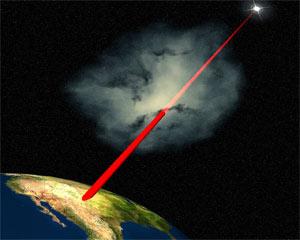One fun thing theorists do is undertake creative projects that predict phenomena that haven't yet been observed experimentally. In fact, sometimes they even predict things no one has ever imagined before. In other cases, the goal is to unravel the mechanism behind an experimental result that initially seems to conflict with the known laws of quantum physics. Fellow Chris Greene's group enjoys self-driven, innovative work in both categories.
Recently, the group received experimental confirmation of theoretical predictions of: (1) the rate of a key chemical reaction in interstellar gas clouds and (2) the characteristics of unusual states created by quantum processes in three-particle systems. The interstellar chemical reaction is known as dissociative recombination. It occurs when an electron collides with an ion containing three hydrogen atoms, or H3+. In work carried out from 2001 to 2003, Greene; Viatcheslav Kokoouline, a former JILA postdoc now at the University of Central Florida; and Brett Esry, a former JILA graduate student now at Kansas State University, showed that free, low-energy electrons can blow apart H3+ with surprising efficiency. The reaction forms either three hydrogen atoms or a hydrogen molecule (H2) and a hydrogen atom.
Recent experiments performed at Sweden's CRYRING storage ring and Germany's Test Storage Ring confirmed the Greene group's prediction that the rate of this reaction is quite fast under interstellar conditions. This was good news because there were early, less well-controlled measurements of the recombination rate suggesting that it was at least 1000 times faster than the standard models of this process suggested. The impressive recent refinements of the original experiments, in combination with new theoretical work, have eliminated all remaining doubt. Since H3+ disappears so rapidly, astrophysicists must now explain its abundance in interstellar gas clouds. A likely explanation is an enhanced rate of ionization by cosmic rays.
Back on Earth, Greene saw experimental confirmation in 2006 of predictions that he, Esry, C.D. Lin, a JILA visitor from Kansas State University, and J. P. Burke, a former JILA graduate student, made from 1996 to 1999 about Efimov states. These states, originally predicted by Vitaly Efimov in 1970, derive from a bizarre quantum-mechanical effect occurring in three particle systems. The researchers' analysis addressed both the characteristics of and possible ways to observe Efimov states in three-body combination. Under certain circumstances, the three particles can produce an infinite number of bound levels even though no two of them are capable of forming a stable pair. - Julie Phillips



 The Physics Frontiers Centers (PFC) program supports university-based centers and institutes where the collective efforts of a larger group of individuals can enable transformational advances in the most promising research areas. The program is designed to foster major breakthroughs at the intellectual frontiers of physics by providing needed resources such as combinations of talents, skills, disciplines, and/or specialized infrastructure, not usually available to individual investigators or small groups, in an environment in which the collective efforts of the larger group can be shown to be seminal to promoting significant progress in the science and the education of students. PFCs also include creative, substantive activities aimed at enhancing education, broadening participation of traditionally underrepresented groups, and outreach to the scientific community and general public.
The Physics Frontiers Centers (PFC) program supports university-based centers and institutes where the collective efforts of a larger group of individuals can enable transformational advances in the most promising research areas. The program is designed to foster major breakthroughs at the intellectual frontiers of physics by providing needed resources such as combinations of talents, skills, disciplines, and/or specialized infrastructure, not usually available to individual investigators or small groups, in an environment in which the collective efforts of the larger group can be shown to be seminal to promoting significant progress in the science and the education of students. PFCs also include creative, substantive activities aimed at enhancing education, broadening participation of traditionally underrepresented groups, and outreach to the scientific community and general public.